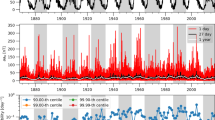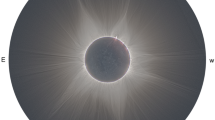Abstract
A Polish-made vertical ionosonde (VI) has been operated at the Kandilli Observatory in Istanbul, for almost one year (May 1993 - April 1994) as part of the COST 238, PRIME Project, The critical frequencies were obtained for every half-hour interval. The data obtained during this campaign, on the descending branch of solar cycle 22, and the data measured earlier in Istanbul for cycle 20 were analysed and the characteristic behaviour of the F2 region ionosphere over Istanbul has been determined. This is a unique data set for this area. Several markers of the solar cycle activities in terms of the daily relative sunspot numbers, F10.7 cm solar radio flux and solar flare index, and the magnetic daily index of Ap were then used to seek the possible influence of the solar and ionospheric activities on the critical frequencies observed in Istanbul. It was found that the solar flare index, as a solar activity index, was more reliable in determining quiet ionospheric days. It is shown that the minimum and maximum time values of the solar activity are more convenient for ionospheric prediction and modelling.
Similar content being viewed by others
References
Bradley P.A., 1994: Further Study of foF2 and M(3000)F2 in Different Solar Cycles. Annali di Geofisica, 37, 201–208.
Kane R.P., 1992: Solar Cycle Variations of foF2. J. Atm. Terr. Phys., 54, 1201–1205.
Kleczek J., 1952: The Calculation of Solar Flare Index. Publ. Centr. Inst. Astron. No. 22.
Kouris S.S., 1995: On the Hysteresis Observed Between Ionospheric Characteristics. Adv. Space Res., 15, 89–91.
Kouris S.S., Alberca L.F., Apostolov E.M., Hanbaba R., Xenos Th.D. and Zolesi B., 1993: Proposals for the Solar-Cycle Variation of foF2 (Part II). PRIME Studies with Emphasis on TEC and Topside Modelling, Graz University, Graz. 1993, 89–90.
Laštovička J., 1993: Solar Flare Occurrence and Ionospheric Disturbances. PRIME Studies with Emphasis on TEC and Topside Modelling, Graz University, Graz 1993, 229–235.
Mikhailov A.V. and Mikhailov V.V., 1995: A New Ionospheric Index. Adv. Space Res., 15, 93–97.
Özgüç A., Tulunay Y. and Ataç T., 1998: Examination of the Solar Cycle Variations of foF2 by Using Solar Flare Index for the Cycle 21. Adv. Space Res. (in press).
Rokicki A., Stanislawska I., Zbyszynski Z., Tulunay Y., Özgüç A., Ataç T., Altaş L. and Barlas O., 1993: First Results from the Transportable Ionosonde Campaign. PRIME Studies with Emphasis on TEC and Topside Modelling, Graz University, Graz 1993, 297–301.
Sizun H., 1992: F2–Layer Critical Frequency Modelisation as a Function of Upward and Downward Phase of Solar Activity Cycle. Proceedings of the PRIME/URSI, Memoria 16, 205–217.
Author information
Authors and Affiliations
Rights and permissions
About this article
Cite this article
Özgüç, A., Ataç, T., Tulunay, Y. et al. The Ionospheric foF2 Data over Istanbul and their Response to Solar Activity for the Years 1964–1969 and 1993. Studia Geophysica et Geodaetica 42, 112–118 (1998). https://doi.org/10.1023/A:1023348802826
Published:
Issue Date:
DOI: https://doi.org/10.1023/A:1023348802826




